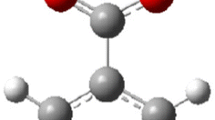Abstract
The intriguing decompositions of nitro-containing explosives have been attracting interest. While theoretical investigations have long been concentrated mainly on unimolecular decompositions, bimolecular reactions have received little theoretical attention. In this paper, we investigate theoretically the bimolecular reactions between nitromethane (CH3NO2)—the simplest nitro-containing explosive—and its decomposition products, such as NO2, NO and CO, that are abundant during the decomposition process of CH3NO2. The structures and potential energy surface (PES) were explored at B3LYP/6-31G(d), B3P86/6-31G(d) and MP2/6-311 + G(d,p) levels, and energies were refined using CCSD(T)/cc-pVTZ methods. Quantum chemistry calculations revealed that the title reactions possess small barriers that can be comparable to, or smaller than, that of the initial decomposition reactions of CH3NO2. Considering that their reactants are abundant in the decomposition process of CH3NO2, we consider bimolecular reactions also to be of great importance, and worthy of further investigation. Moreover, our calculations show that NO2 can be oxidized by CH3NO2 to NO3 radical, which confirms the conclusion reached formerly by Irikura and Johnson [(2006) J Phys Chem A 110:13974–13978] that NO3 radical can be formed during the decomposition of nitramine explosives.


Similar content being viewed by others
References
Chakraborty D, Muller RP, Dasgupta S, Goddard WA III (2000) J Phys Chem A 104:2261–2272
Guo F, Cheng XL, Zhang H (2012) J Phys Chem A 116:3514–3520
Guo F, Cheng XL, Zhang H (2009) J Theor Comput Chem 9:315–325
Hu WF, He TJ, Chen DM, Liu FC (2002) J Phys Chem A 106:7294–7303
Rom N, Zybin SV, van Duin ACT, Goddard WA III, Zeiri Y, Katz G, Kosloff R (2011) J Phys Chem A 115:10181–10202
Citroni M, Datchi F, Bini R, Vaira MD, Pruzan P (2008) J Phys Chem B 112:1095–1103
Irikura KK, Johnson RD (2006) J Phys Chem A 110:13974–13978
da Silva G, Bozzelli JW, Asatryan R (2009) J Phys Chem A113:8596–8606
Frisch MJ, Trucks GW, Schlegel HB, Scuseria GE, Robb MA, Cheeseman JR, Scalmani G, Barone V, Mennucci B, Petersson GA, Nakatsuji H, Caricato M, Li X, Hratchian HP, Izmaylov AF, Bloino J, Zheng G, Sonnenberg JL, Hada M, Ehara M, Toyota K, Fukuda R, Hasegawa J, Ishida M, Nakajima T, Honda Y, Kitao O, Nakai H, Vreven T, Montgomery JA Jr, Peralta JE, Ogliaro F, Bearpark M, Heyd JJ, Brothers E, Kudin KN, Staroverov VN, Kobayashi R, Normand J, Raghavachari K, Rendell A, Burant JC, Iyengar SS, Tomasi J, Cossi M, Rega N, Millam JM, Klene M, Knox JE, Cross JB, Bakken V, Adamo C, Jaramillo J, Gomperts R, Stratmann RE, Yazyev O, Austin AJ, Cammi R, Pomelli C, Ochterski JW, Martin RL, Morokuma K, Zakrzewski VG, Voth GA, Salvador P, Dannenberg JJ, Dapprich S, Daniels AD, Farkas O, Foresman JB, Ortiz JV, Cioslowski J, Fox DJ (2010) Gaussian 09, Revision B.01. Gaussian, Inc, Wallingford
Becke AD (1993) J Chem Phys 98:5648–5652
Li QS, Zhang Y, Zhang SW (2004) J Phys Chem A 108:2014–2019
Zhang JD, Cheng XL (2012) J Chem Phys 137:214317
Zhang JD, Wang HF, Xue XY, Zhang YW, Cheng XL (2012) Acta Chim Sin 70:2543–2548
Su XF, Cheng XL, Meng CM, Yuan XL (2009) J Hazard Mater 161:551–558
Gonzalez C, Schlegel HB (1990) J Phys Chem 94:5523–5527
Curtiss LA, Raghavachari K, Redfern PC, Rassolov V, Pople JA (1998) J Chem Phys 109:7764–7776
Boboul AG, Curtiss LA, Redfern PC, Raghavachari K (1999) J Chem Phys 110:7650–7657
Benson SW (1976) Thermochemical Kinetics. Wiley, New York
Batt L, Robinson GN (1982) The chemistry of amino, nitroso, and nitro compounds and their derivatives. In: Patai S (ed) Wiley, New York
Mckee ML (1986) J Am Chem Soc 108:5784–5792
Zhu RS, Lin MC (2009) Chem Phys Lett 478:11–16
Homayoon Z, Bowman JM (2013) J Phys Chem A 117:11665–11672
Acknowledgments
This project was supported by the National Natural Science Foundation of China (No. 21363019).
Author information
Authors and Affiliations
Corresponding author
Electronic supplementary material
Below is the link to the electronic supplementary material.
Table S1
(DOC 54 kb)
Rights and permissions
About this article
Cite this article
Zhang, JD., Kang, LH. & Cheng, XL. Theoretical study of the reaction mechanism of CH3NO2 with NO2, NO and CO: the bimolecular reactions that cannot be ignored. J Mol Model 21, 13 (2015). https://doi.org/10.1007/s00894-014-2568-y
Received:
Accepted:
Published:
DOI: https://doi.org/10.1007/s00894-014-2568-y




